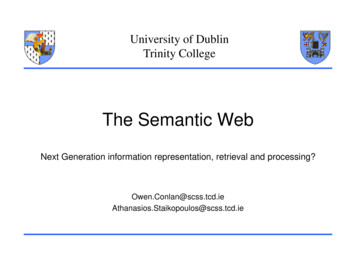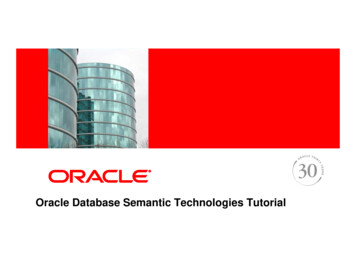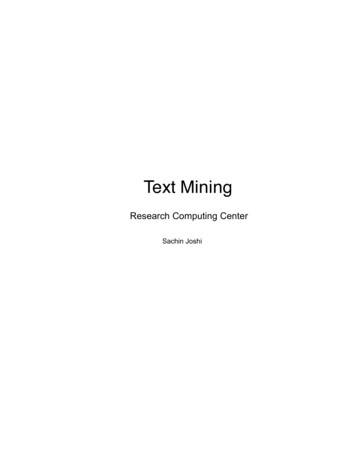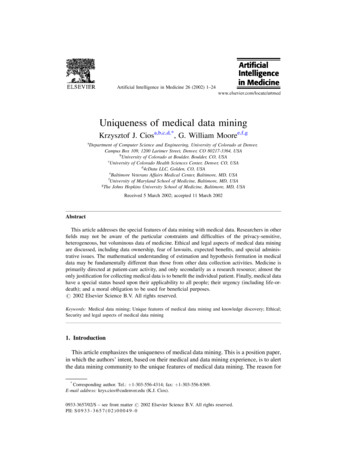
Transcription
Data MiningCluster AnalysisUniversity of Mannheim – Prof. Bizer: Data MiningSlide 1
Outline1. What is Cluster Analysis?2. K-Means Clustering3. Density-based Clustering4. Hierarchical Clustering5. Proximity MeasuresUniversity of Mannheim – Prof. Bizer: Data MiningSlide 2
1. What is Cluster Analysis? Finding groups of objects such that the objects in a group will be similar to one another and different from the objects in other groups. Goal: Get a better understanding of the dataIntra-clusterdistances areminimizedUniversity of Mannheim – Prof. Bizer: Data MiningInter-clusterdistances aremaximizedSlide 3
Types of Clusterings Partitional Clustering A division of data objects into non-overlapping subsets (clusters)such that each data object is in exactly one subsetClustering Hierarchical Clustering A set of nested clusters organized as a hierarchical treep1p3Dendrogramp4p2p1 p2University of Mannheim – Prof. Bizer: Data Miningp3 p4Slide 4
Aspects of Cluster Analysis A clustering algorithm Partitional algorithms Density-based algorithms Hierarchical algorithms A proximity (similarity, or dissimilarity) measure Euclidean distanceCosine similarityData type-specific similarity measuresDomain-specific similarity measures Clustering quality Intra-clusters distance minimized Inter-clusters distance maximized The clustering should be useful with regard to the goal of the analysisUniversity of Mannheim – Prof. Bizer: Data MiningSlide 5
The Notion of a Cluster is AmbiguousHow many clusters do you see?Two ClustersSix ClustersFour ClustersThe usefulness of a clustering dependson the goal of the analysisUniversity of Mannheim – Prof. Bizer: Data MiningSlide 6
Example Application 1: Market Segmentation Goal: Identify groups of similar customers Level of granularity depends on the task at hand Relevant customer attributes depend on the task at handUniversity of Mannheim – Prof. Bizer: Data MiningSlide 7
Example Application 2: E-Commerce Identify offers of the same product on electronic marketsUniversity of Mannheim – Prof. Bizer: Data MiningSlide 8
Example Application 3: Image Recognition Identify parts of an image that belong to the same objectUniversity of Mannheim – Prof. Bizer: Data MiningSlide 9
Cluster Analysis as Unsupervised Learning Supervised learning: Discover patterns in the data that relatedata attributes with a target (class) attribute these patterns are then utilized to predict the values of thetarget attribute in unseen data instances the set of classes is known before training data is often provided by human annotators Unsupervised learning: The data has no target attribute we want to explore the data to find some intrinsic patterns in it the set of classes/clusters is not known before no training data is used Cluster Analysis is an unsupervised learning taskUniversity of Mannheim – Prof. Bizer: Data MiningSlide 10
2. K-Means Clustering Partitional clustering algorithmEach cluster is associated with a centroid (center point)Each point is assigned to the cluster with theclosest centroidNumber of clusters K must be specified manually The K-Means algorithm is very simple:University of Mannheim – Prof. Bizer: Data MiningSlide 11
K-Means Example, Step 1k1YRandomlypick 3 initialcentroidsk2k3XUniversity of Mannheim – Prof. Bizer: Data MiningSlide 12
K-Means Example, Step 2k1YAssigneach pointto the closestcentroidk2k3XUniversity of Mannheim – Prof. Bizer: Data MiningSlide 13
K-Means Example, Step 3k1k1YMoveeach centroidto the meanof each clusterk2k3k2k3XUniversity of Mannheim – Prof. Bizer: Data MiningSlide 14
K-Means Example, Step 4Reassignpoints if theyare nowcloser to a YdifferentcentroidQuestion:Which pointsare reassigned?k1k3k2XUniversity of Mannheim – Prof. Bizer: Data MiningSlide 15
K-Means Example, Step 4k1YAnswer:Three pointsare reassignedk3k2XUniversity of Mannheim – Prof. Bizer: Data MiningSlide 16
K-Means Example, Step 5k1Y1. Re-computecluster means2. Movecentroids tonew clustermeansk3k2XUniversity of Mannheim – Prof. Bizer: Data MiningSlide 17
Convergence CriteriaDefault convergence criterion no (or minimum) change of centroidsAlternative convergence criteria1.no (or minimum) re-assignments of data pointsto different clusters2.stop after x iterations3.minimum decrease in the sum of squared error (SSE) see next slideUniversity of Mannheim – Prof. Bizer: Data MiningSlide 18
Evaluating K-Means Clusterings Widely used cohesion measure: Sum of Squared Error (SSE) For each point, the error is the distance to the nearest centroid To get SSE, we square these errors and sum themkSSE x C dist ( x, m j )j 1 2jCj is the j-th clustermj is the centroid of cluster Cj (the mean vector of all the data points in Cj)dist(x, mj) is the distance between data point x and centroid mj Given several clusterings ( groupings), we should preferthe one with the smallest SSEUniversity of Mannheim – Prof. Bizer: Data MiningSlide 19
Illustration: Sum of Squared Error Cluster analysis problem Good clustering small distances to centroids Not so good clustering larger distances to centroidsUniversity of Mannheim – Prof. Bizer: Data MiningSlide 20
K-Means Clustering – Second ExampleIteration 1Iteration 2Iteration 1-0.500.511.52-2-1.5-1-0.5x00.511.52-2Iteration 4Iteration .5211.52y2.5y2.5y3-1-0.5Iteration 63-1.5-1x3-2-1.5x-2-1.5-1xUniversity of Mannheim – Prof. Bizer: Data Mining-0.50x0.511.52-2-1.5-1-0.500.5xSlide 21
Weaknesses of K-Means: Initial SeedsClustering results may vary significantly depending oninitial choice of seeds (number and position of seeds)University of Mannheim – Prof. Bizer: Data MiningSlide 22
Weaknesses of K-Means: Initial SeedsIf we use different seeds, we get good resultsUniversity of Mannheim – Prof. Bizer: Data MiningSlide 23
Bad Initial Seeds – Second ExampleIteration 1Iteration -2-1.5-1-0.5x00.5Iteration 52Iteration 53-1.51.5Iteration 43-21x11.52-2-1.5xUniversity of Mannheim – Prof. Bizer: Data Mining-1-0.50x0.511.52-2-1.5-1-0.500.511.52xSlide 24
Increasing the Chance of Finding Good Clusters1. Restart a number of times with different random seeds chose the resulting clustering with the smallest sum of squarederror (SSE)2. Run k-means with different values of k The SSE for different values of k cannot directly be compared think: what happens for k number of examples?Workarounds1. Choose k where SSE improvementdecreases (knee value of k)2. Employ X-Means variation of K-Means algorithmthat automatically determines kstarts with small k, then splits largeclusters until improvement decreasesUniversity of Mannheim – Prof. Bizer: Data Miningknee valueSlide 25
Weaknesses of K-Means: Problems with Outliers(A): Undesirable clusters(B): Better clustersUniversity of Mannheim – Prof. Bizer: Data MiningSlide 26
Weaknesses of K-Means: Problems with OutliersApproaches to deal with outliers:1. K-Medoids K-Medoids is a K-Means variation that uses the median of eachcluster instead of the mean Medoids are the most central existing data points in each cluster K-Medoids is more robust against outliers as the median is lessaffected by extreme values: Mean and Median of 1, 3, 5, 7, 9 is 5 Mean of 1, 3, 5, 7, 1009 is 205 Median of 1, 3, 5, 7, 1009 is 52. DBSCAN Density-based clustering method that removes outliers see next sectionUniversity of Mannheim – Prof. Bizer: Data MiningSlide 27
K-Means Clustering SummaryAdvantagesDisadvantages Simple, understandable Need to determinenumber of clusters Efficient time complexity:O(n * K * I * d )where n number of points K number of clusters I number of iterations d number of attributesUniversity of Mannheim – Prof. Bizer: Data Mining All items are forcedinto a cluster Sensitive to outliers Does not work fornon-globular clustersSlide 28
K-Means Clustering in RapidMiner and PythonRapidMinerPythonUniversity of Mannheim – Prof. Bizer: Data MiningSlide 29
K-Means Clustering ResultsNew cluster attributeUniversity of Mannheim – Prof. Bizer: Data MiningSlide 30
3. Density-based ClusteringChallenging use case for K-Means because Problem 1: Non-globular shapes Problem 2: Outliers / noise pointsUniversity of Mannheim – Prof. Bizer: Data MiningSlide 31
DBSCAN DBSCAN is a density-based algorithm Density number of points within a specified radius Epsilon (Eps) Divides data points into three classes:1. A point is a core point if it has at least a specified number ofneighboring points (MinPts) within the specified radius Eps the point itself is counted as well these points form the interior of a dense region (cluster)2. A border point has fewer points than MinPts within Eps, but isin the neighborhood of a core point3. A noise point is any point that is not a core point or a border pointUniversity of Mannheim – Prof. Bizer: Data MiningSlide 32
Examples of Core, Border, and Noise Points 1University of Mannheim – Prof. Bizer: Data MiningSlide 33
Examples of Core, Border, and Noise Points 2Original PointsUniversity of Mannheim – Prof. Bizer: Data MiningPoint types: core,border and noiseSlide 34
The DBSCAN AlgorithmEliminates noise points and returns clustering of the remaining points:1. Label all points as core, border, or noise points2. Eliminate all noise points3. Put an edge between all core points that are within Eps of eachother4. Make each group of connected core points into a separate cluster5. Assign each border point to one of the clusters of its associatedcore points as a border point can be at the border of multiple clusters use voting if core points belong to different clusters if equal vote, than assign border point randomlyTime complexity: O(n log n) dominated by neighborhood search for each point using an indexUniversity of Mannheim – Prof. Bizer: Data MiningSlide 35
How to Determine Suitable Eps and MinPts Values?For points in a cluster, their kth nearest neighbor (single point) should be at roughlythe same distance. Noise points have their kth nearest neighbor at farther distance1. Start with setting MinPts 4 (rule of thumb)2. Plot sorted distance of every point to its kth nearest neighbor:Eps 93. Set Eps to the sharp increase of the distances (start of noise points)4. Decrease k if small clusters are labeled as noise (subjective decision)5. Increase k if outliers are included into the clusters (subjective decision)University of Mannheim – Prof. Bizer: Data MiningSlide 36
When DBSCAN Works WellOriginal PointsClusters Resistant to noise Can handle clusters of different shapes and sizesUniversity of Mannheim – Prof. Bizer: Data MiningSlide 37
When DBSCAN Does NOT Work Well(MinPts 4, Eps 9.92)Original PointsDBSCAN has problems withdatasets of varying densities.(MinPts 4, Eps 9.75)University of Mannheim – Prof. Bizer: Data MiningSlide 38
DBSCAN in RapidMiner and PythonRapidMinerPythonUniversity of Mannheim – Prof. Bizer: Data MiningSlide 39
4. Hierarchical Clustering Produces a set of nested clusters organized as a hierarchical tree Can be visualized as a dendrogram A tree like diagram that records the sequences of merges or splits The y-axis displays the former distance between merged ity of Mannheim – Prof. Bizer: Data Mining0132546Slide 40
Strengths of Hierarchical Clustering We do not have to assume any particular number of clusters any desired number of clusters can be obtained by ‘cutting’the dendogram at the proper level May be used to discover meaningful taxonomies taxonomies of biological species taxonomies of different customer groupsUniversity of Mannheim – Prof. Bizer: Data MiningSlide 41
Two Main Types of Hierarchical Clustering Agglomerative start with the points as individual clusters at each step, merge the closest pair of clusters until onlyone cluster (or k clusters) is left Divisive start with one, all-inclusive cluster at each step, split a cluster until each cluster contains a single point(or there are k clusters) Agglomerative Clustering is more widely usedUniversity of Mannheim – Prof. Bizer: Data MiningSlide 42
Agglomerative Clustering AlgorithmThe basic algorithm is straightforward:1.2.3.Compute the proximity matrixLet each data point be a clusterRepeat1. Merge the two closest clusters2. Update the proximity matrixUntil only a single cluster remains The key operation is the computation of the proximityof two clustersThe different approaches to defining the distancebetween clusters distinguish the different algorithmsUniversity of Mannheim – Prof. Bizer: Data MiningSlide 43
Starting SituationStart with clusters of individual points and a proximity matrixp1 p2 p3 p4 p5p3p1d12d13 p1p2p3p4p5.d12d13. Proximity Matrixp2University of Mannheim – Prof. Bizer: Data MiningSlide 44
Intermediate Situation After some merging steps, we have larger clusters. We want to keep on merging the two closest clustersC2(C2 and C5?)C1C3C4C3C4?C1?C2 U C5UC5?C3?C4?Proximity MatrixC1C1C2C2C5C5University of Mannheim – Prof. Bizer: Data MiningSlide 45
How to Define Inter-Cluster Similarity?Similarity?Different approaches are used:1. Single Link2. Complete Link3. Group Average4. Distance Between CentroidsUniversity of Mannheim – Prof. Bizer: Data MiningSlide 46
Cluster Similarity: Single Link Similarity of two clusters is based on thetwo most similar (closest) points in the different clusters Determined by one pair of points,i.e. by one link in the proximity graphUniversity of Mannheim – Prof. Bizer: Data MiningSlide 47
Example: Single Link13550.2212340.1564Nested ClustersUniversity of Mannheim – Prof. Bizer: Data Mining0.10.050362541DendrogramSlide 48
Cluster Similarity: Complete Linkage Similarity of two clusters is based on thetwo least similar (most distant) points in the different clusters Determined by all pairs of points in the two clustersUniversity of Mannheim – Prof. Bizer: Data MiningSlide 49
Example: Complete Linkage412550.40.3520.30.2533614Nested ClustersUniversity of Mannheim – Prof. Bizer: Data Mining0.20.150.10.050364125DendrogramSlide 50
Single Link vs. Complete Linkage Single Link– Strength: Can handle non-elliptic shapes– Limitation: Sensitive to noise and outliers Complete Linkage– Strength: Less sensitive to noise and outliersOutliers– Limitation: Biased towards globular clusters– Limitation: Tends to break large clusters,as decisions can not be undone.University of Mannheim – Prof. Bizer: Data MiningSlide 51
Cluster Similarity: Group Average Proximity of two clusters is the average of pair-wise proximitybetween all points in the two clusters. proximity( p , pproximity( Cluster i , Cluster j ) p i Cluster ip j Cluster jij) Cluster i Cluster j Compromise between single and complete link Strength: Less sensitive to noise and outliers than single link Limitation: Biased towards globular clustersUniversity of Mannheim – Prof. Bizer: Data MiningSlide 52
Example: Group Average541250.250.220.1536143Nested ClustersUniversity of Mannheim – Prof. Bizer: Data Mining0.10.050364125DendrogramSlide 53
Hierarchical Clustering: Problems and Limitations Different schemes have problems with one or more of thefollowing:1. sensitivity to noise and outliers2. difficulty handling non-elliptic shapes3. breaking large clusters High space and time complexity O(N2) space since it uses the proximity matrix N is the number of points O(N3) time in many cases there are N steps and at each step the size N2 proximity matrix must besearched and updated complexity can be reduced to O(N2 log(N)) time in some cases Workaround: Apply hierarchical clustering to a random sample of theoriginal data ( 10,000 examples)University of Mannheim – Prof. Bizer: Data MiningSlide 54
Agglomerative Hierarchical Clustering in RapidMinerCreateshierarchical clusteringFlattens clustering to a givennumber of clustersUniversity of Mannheim – Prof. Bizer: Data MiningSlide 55
Agglomerative Hierarchical Clustering in PythonChoose inter-clustersimilarity metric, e.g.‘single’, ‘complete’,‘average’, ‘centroid’University of Mannheim – Prof. Bizer: Data MiningSlide 56
5. Proximity Measures So far, we have seen different clustering algorithmsall of which rely on proximity (distance, similarity, .) measures Now, we discuss proximity measures in more detail A wide range of different measures is used depending on therequirements of the application Similarity Numerical measure of how alike two data objects are Often falls in the range [0,1] Dissimilarity / Distance Numerical measure of how different are two data objects Minimum dissimilarity is often 0, upper limit varies We distinguish proximity measures for single attributes andmeasures for multidimensional data points (records)University of Mannheim – Prof. Bizer: Data MiningSlide 57
5.1 Proximity of Single Attributesp and q are attribute values for two data objectsUniversity of Mannheim – Prof. Bizer: Data MiningSlide 58
Levenshtein Distance Measures the dissimilarity of two strings Measures the minimum number of edits neededto transform one string into the other Allowed edit operations:1. insert a character into the string2. delete a character from the string3. replace one character with a different character Examples: levensthein('table', 'cable') 1 (1 substitution) levensthein('Bizer, Chris', 'Chris Bizer') 11 (10 substitution,1 deletion)University of Mannheim – Prof. Bizer: Data MiningSlide 59
Further Similarity MeasuresSee course:Web Data rdWords / pecificGeoCoordinatesSets ofValuesHybridSoft TF-IDFEmbedding-basedfastTextUniversity of Mannheim – Prof. Bizer: Data MiningPhoneticKölnerPhonetikBERTSoundexSlide 60
5.2 Proximity of Multidimensional Data Points All measures discussed so far cover the proximity ofsingle attribute values But we usually have data points with many attributes e.g., age, height, weight, sex.Thus, we need proximity measures for data points taking multiple attributes/dimensions into accountUniversity of Mannheim – Prof. Bizer: Data MiningSlide 61
Euclidean DistanceDefinitiondist n ( pk qk )2k 1Where n is the number of dimensions (attributes) andpk and qk are the kth attributes of data points p and q pk - qk is squared to increase impact of long distances All dimensions are weighted equalityUniversity of Mannheim – Prof. Bizer: Data MiningSlide 62
Example: Euclidean 21.41402p45.0993.16220Distance MatrixUniversity of Mannheim – Prof. Bizer: Data MiningSlide 63
Normalization Attributes should be normalized so that all attributes canhave equal impact on the computation of distances Consider the following pair of data points xi: (0.1, 20) and xj: (0.9, 720).dist ( x i , x j ) ( 0 .9 0 .1) ( 720 20 ) 700.00045722 The distance is almost completely dominated by(720-20) 700 Solution: Normalize attributes to all have a common valuerange, for instance [0,1]University of Mannheim – Prof. Bizer: Data MiningSlide 64
Normalization in RapidMiner and PythonRapidMinerPythonUniversity of Mannheim – Prof. Bizer: Data MiningSlide 65
Similarity of Binary Attributes Common situation is that objects, p and q, haveonly binary attributes products in shopping basketcourses attended by studentsWe compute similarities using the following quantities:M11 the number of attributes where p was 1 and q was 1M00 the number of attributes where p was 0 and q was 0M01 the number of attributes where p was 0 and q was 1M10 the number of attributes where p was 1 and q was 0University of Mannheim – Prof. Bizer: Data MiningSlide 66
Symmetric Binary Attributes A binary attribute is symmetric if both of its states (0 and 1) haveequal importance, and carry the same weights, e.g., male andfemale Similarity measure: Simple Matching CoefficientM 11 M 00SMC ( x i , x j ) M 01 M 10 M 11 M 00Number of matches / number of all attributes valuesUniversity of Mannheim – Prof. Bizer: Data MiningSlide 67
Asymmetric Binary Attributes Asymmetric: If one of the states is more important than the other by convention, state 1 represents the more important state 1 is typically the rare or infrequent state examples: Shopping baskets, word vectors Similarity measure: Jaccard CoefficientM 11J (x i , x j ) M 01 M 10 M 11Number of 11 matches / number of not-both-zero attributes valuesUniversity of Mannheim – Prof. Bizer: Data MiningSlide 68
SMC versus Jaccard: Examplep 1000000000q 0000001001M11 0M00 7M01 2M10 1Interpretation of the example:Customer p bought item 1Customer q bought item 7 and 10(the number of attributes where p was 1 and q was 1)(the number of attributes where p was 0 and q was 0)(the number of attributes where p was 0 and q was 1)(the number of attributes where p was 1 and q was 0)SMC (M11 M00)/(M01 M10 M11 M00) (0 7) / (2 1 0 7) 0.7J (M11) / (M01 M10 M11) 0 / (2 1 0) 0University of Mannheim – Prof. Bizer: Data MiningSlide 69
SMC versus Jaccard: Question Which of the two measures would you use .for a dating agency? hobbies favorite bands favorite movies .for the Wahl-O-Mat? (dis-)agreement with political statements recommendation for votingUniversity of Mannheim – Prof. Bizer: Data MiningSlide 70
Using Weights to Combine Similarities You may not want to treat all attributes the same use weights wk which are between 0 and 1 and sum up to 1 weights are set according to the importance of the attributes Example: Weighted Euclidean Distancedist ( x i , x j ) w1 ( xi1 x j1 ) 2 w2 ( xi 2 x j 2 ) 2 . wr ( xir x jr ) 2University of Mannheim – Prof. Bizer: Data MiningSlide 71
Combining Different Similarity MeasuresUniversity of Mannheim – Prof. Bizer: Data MiningSlide 72
How to Choose a good Clustering Algorithm? “Best” algorithm depends on1. the analytical goals of the specific use case2. the distribution of the data Normalization, feature selection, distance measure, andparameter settings have equally high influence on results Due to these complexities, the common practice is to1. run several algorithms using different distance measures,feature subsets and parameter settings, and2. then visualize and interpret the results based on knowledgeabout the application domain as well as the goals of the analysisUniversity of Mannheim – Prof. Bizer: Data MiningSlide 73
Literature for this SlidesetPang-Ning Tan, Michael Steinbach, Anuj Karpatne,Vipin Kumar: Introduction to Data Mining.2nd Edition. Pearson.Chapter 5: Cluster AnalysisChapter 5.2: K-MeansChapter 5.3: Agglomerative Hierarchical ClusteringChapter 5.4: DBSCANChapter 2.4: Measures of Similarity and DissimilarityUniversity of Mannheim – Prof. Bizer: Data MiningSlide 74
University of Mannheim -Prof. Bizer: Data Mining Slide 32 DBSCAN DBSCAN is a density-based algorithm Density number of points within a specified radius Epsilon (Eps) Divides data points into three classes: 1. A point is a core point if it has at least a specified number of neighboring points (MinPts) within the specified radius Eps











